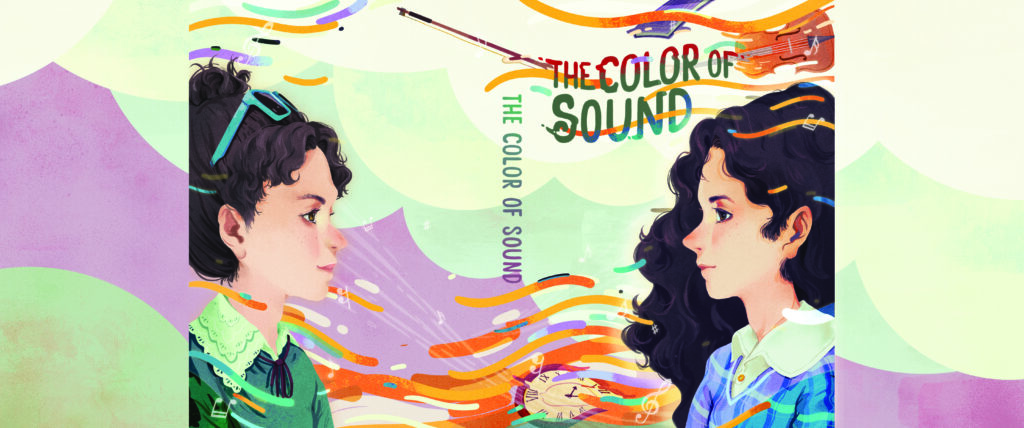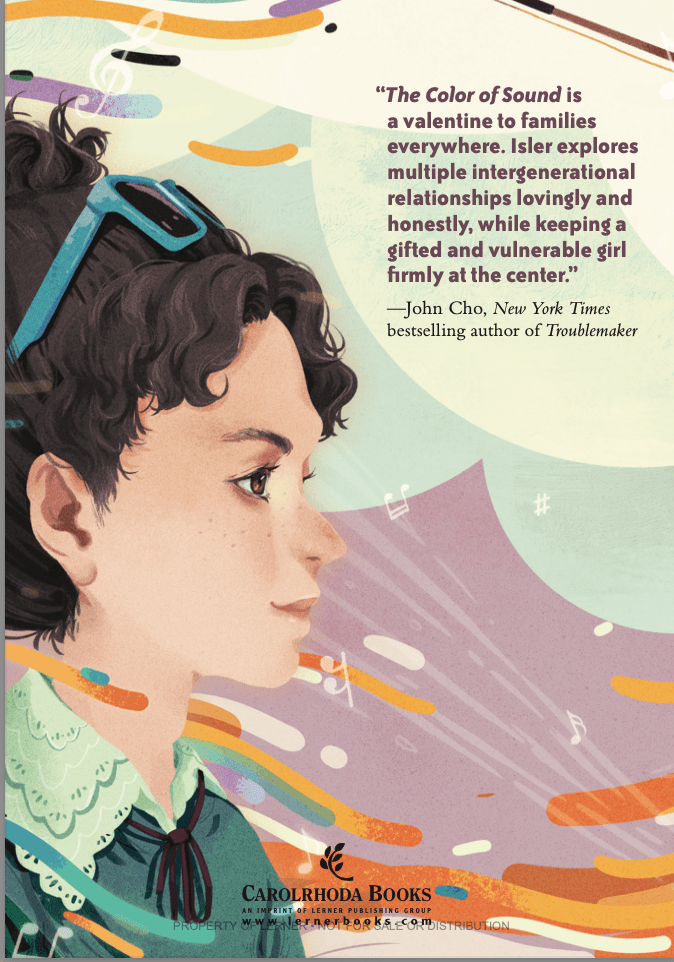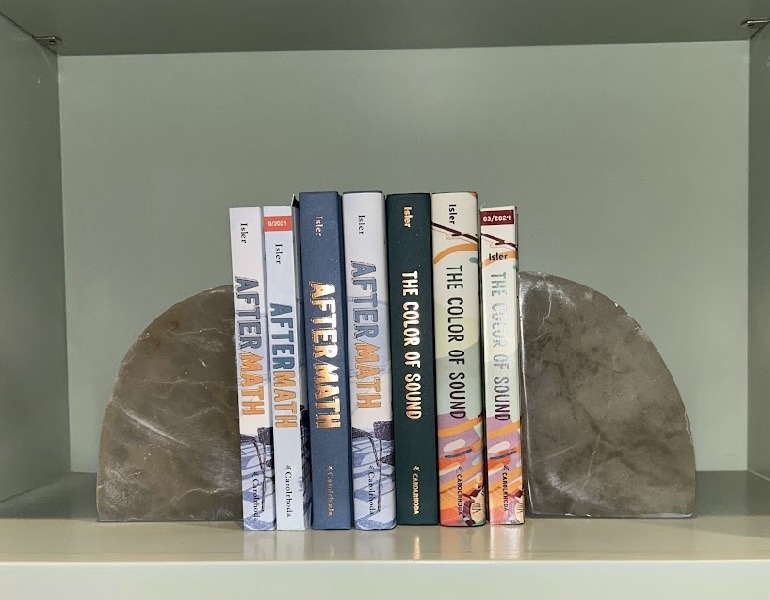Using Time Travel to Explore Parent-Child Relationships, a guest post by Emily Barth Isler

Much of my inspiration for writing middle grade comes from the vivid memories and foundational experiences I recall from my own tween years. It almost feels like a part of my brain still manages to exist in its form from thirty years ago, because some of those experiences still feel so fresh and urgent to my forty-something self. However, one of several seeds that eventually grew into my second novel, The Color of Sound, came from my experience as a parent of tweens now, in the present day. It is the combination of these two experiences that made me want to write about a complicated mother-daughter relationship using a little bit of time travel magic in the plot.
I was already contemplating an idea for a novel about a girl who is a musical prodigy with synesthesia, who is at odds with her overbearing mother, when the time travel idea came about organically. I was trying in vain one night to explain to one of my own kids that I, too, once struggled with shyness and anxiety as a tween, and I found myself saying, “I wish I could go back in time and meet you when I was your age. Then you’d see first-hand how much I relate to what you’re going through!”
ADVERTISEMENT
ADVERTISEMENT
Suddenly, I realized that this was how I wanted to tell the synesthesia/musical prodigy story– using a glitch in time to allow mother and daughter to meet as people who are equal in age, if not in context or experiences, to help them both gain understanding.

In The Color of Sound, twelve year old musical prodigy Rosie stumbles upon a shed on her grandparents’ property and, once inside, meets a girl who is, against all odds, a version of her own mother at age twelve. In present day, Rosie and her mother, Shoshanna, are at odds over Rosie’s violin career. But in this shed, as twelve-year-old girls who are both seeking some self-differentiation and answers about who they want to become, Rosie learns that there is a lot about “Shanna,” as she goes by in her younger years, that shapes and informs the person who eventually becomes her mother, Shoshanna.
Through this time travel element, I was able to not only allow Rosie to learn about her family’s past and secrets, but to introduce the idea that Shoshanna was once a vulnerable, confused, lonely girl in many of the same ways that Rosie is. Like many tweens, Rosie has not spent much time before the start of the book’s action thinking about her mother’s childhood, or what events and ideas may have shaped her into becoming the person she is as a mother in the current day. Rosie has never thought to ask, for example, why it’s so important to her mother that she plays the violin, or why the family doesn’t celebrate many Jewish holidays, or why her mother isn’t particularly close to her own parents.

Rosie is not alone in this. I remember, as a tween, struggling to imagine that my parents, grandparents, teachers, and other adults in my life were ever as young as I was, or that they ever didn’t know precisely who they were or wanted to be. Now, as a grown-up myself, I understand that not only did they not know as tweens who they were, but that many of us adults are still perpetually working on that very question!
The result of the time-glitch interaction in this case is that Rosie questions both the things she’s been required to be– a violin prodigy– and learns about the things she’s been kept from exploring, such as her Jewish heritage, a relationship with her grandparents, and her identity outside of playing the violin.

Rosie’s fear about how this glitch in time might affect the future was a fun way to also introduce the idea that any action we take in life– with or without the added complication of time travel– has implications and echoing repercussions. She sees how her mother’s own stifled desires to play a musical instrument bubble up in the present day in the form of Shoshanna adamantly forcing Rosie to play violin at the cost of all other aspects of her waning childhood experience. Rosie fears that if she rights the perceived wrongs in her mother’s life, she, herself, might cease to exist in the new, altered reality going forward.
Writing the book also gave me the chance to imagine what I would feel in each character’s place— if I were Rosie, and got to talk to my own mother when we were both twelve, as well as I if I were Shoshanna, talking to my daughter as someone who is her same age. What a gift to conceptualize: what would I say, what would I ask? What do I wish I could have told my twelve year old self if I could time travel?
I know I would have tried to tell her not to worry so much, that everything “turns out” okay. I got to exercise a little bit of that wish fulfillment through Rosie, who eventually tells Shanna that her biggest fear– losing her mom– won’t happen for many, many years.
But then, back to the question of repercussions of time travel, I have to wonder: would I have believed myself? And if I did– had I somehow convinced my younger self to not worry so much and particularly about losing my loved ones– would I have grown to be a different person altogether?
And what, if anything, is to be gained from this line of questioning, other than for me to be a more sympathetic daughter, a more empathetic mother, and a more inquisitive writer? Perhaps that is the only kind of ripple effect we can ever hope for in life.
I was twelve years old in 1992, but the feelings and struggles at the root of my memories are similar to the things I see kids working through today, no matter how different our world may seem. People always ask me what it’s like to try and remember being twelve, to slip on those too-tight, metaphorical shoes and walk a few blocks to get into the mindset. It’s not that difficult for me.

One thing I love about writing for a middle grade audience is that the books are often read by both kids and adults– parents and caretakers reading with their children or teachers reading with their students– and while those middle grade years are so much about kids differentiating from their adults, they still need them and rely on them for so many things. I like to write adult characters who are flawed and real, who learn and grow as much as the kid characters do (hopefully!). I like showing kid readers that we grownups are humans, too, that we make mistakes and fix them, that we do not always have the right answers, that we have hopes and dreams like they do, and, above all, that we see them and want to help them be their truest selves.
Check out the Rafflecopter giveaway to win a hardcover copy of THE COLOR OF SOUND. US entries only. 1 winner will be selected March 15.
Meet the author

Emily Barth Isler is the award-winning author of middle grade novels AfterMath and The Color of Sound, and forthcoming picture book, Always Enough Love (Nancy Paulsen Books, Spring 2026).
ADVERTISEMENT
ADVERTISEMENT
Emily is a passionate advocate for gun control in America, and has written extensively on the topic for publications like Publisher’s Weekly, Today.com and Kveller.com. She also writes regularly about sustainability and organic/eco-friendly skincare products for Oprah Daily, Allure, Organic Spa, and more.
Born and raised in Columbia, Maryland, Emily earned a B.A. in Film Studies from Wesleyan University, lived in New York City for almost 20 years, and now lives in Los Angeles, California, with her husband and their two kids.
About The Color of Sound
Twelve-year-old Rosie is a musical prodigy whose synesthesia allows her to see music in colors.
Her mom has always pushed her to become a concert violinist, but this summer Rosie refuses to play, wanting a “normal” life. Forced to spend the summer with her grandparents, Rosie is excited to meet another girl her age hanging out on their property. The girl is familiar, and Rosie quickly pieces it together: somehow, this girl is her mother, when her mother was twelve.
With help from this glitch in time—plus her grandparents, an improv group, and a new instrument—Rosie comes to understand her mother, herself, and her love of music in new ways.
ISBN-13: 9781728487779
Publisher: Lerner Publishing Group
Publication date: 03/05/2024
Age Range: 11 – 12 Years
Filed under: Guest Post
About Amanda MacGregor
Amanda MacGregor works in an elementary library, loves dogs, and can be found on Twitter @CiteSomething.
ADVERTISEMENT
ADVERTISEMENT
SLJ Blog Network
The Origins of The Giant Jam Sandwich (with full credit to Christina Hoover Moorehead)
Mr. Muffins Defender of the Stars | This Week’s Comics
Predictions for the ALA Youth Media Awards
When Book Bans are a Form of Discrimination, What is the Path to Justice?
Our 2025 Preview Episode!
ADVERTISEMENT







